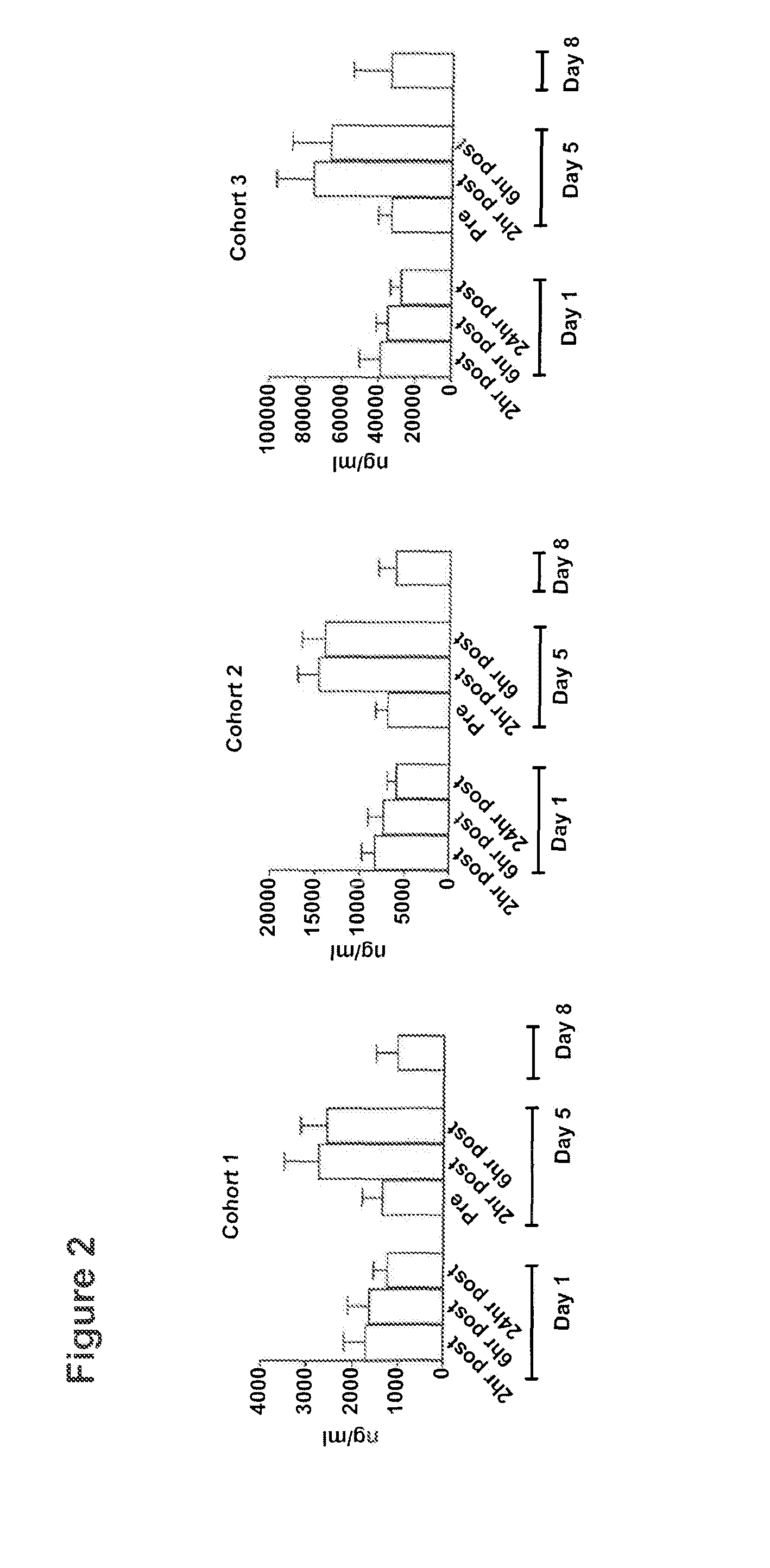Cancer treatment and monitoring methods using ox40 agonists
a monitoring method and technology of ox40, applied in the field of cancer treatment and monitoring methods using ox40 agonists, can solve the problems of ineffective treatment and loss of t cell function, and achieve the effect of increasing the proportion of t-lymphocytes expressing and increasing the level of ki-67 expression
- Summary
- Abstract
- Description
- Claims
- Application Information
AI Technical Summary
Benefits of technology
Problems solved by technology
Method used
Image
Examples
example 1
Clinical Trial Protocol
[0129]This Example describes a phase 1 dose-escalation clinical trial in which advanced cancer patients were treated with a murine anti-OX40 monoclonal antibody (mAb). Patients with metastatic solid malignancies (e.g. prostate, renal, melanoma, gastrointestinal, ovarian, and lung cancer) refractory to conventional therapy were enrolled in a phase 1 dose-escalation clinical trial using the 9B12 murine agonistic anti-human OX40 mAb (see below). Individuals, at least 18 years old, with measurable or evaluable metastatic cancer not curable with standard surgery, chemotherapy or radiation were eligible for the trial. Other eligibility criteria included Eastern Cooperative Oncology Group (ECOG) performance status 0-2 (see: Oken, M. M, et al., Am J Clin Oncol 5:649-655, (1982), adequate hematologic, renal, cardiac and hepatic function, and the ability to comprehend and sign a written informed consent document. Major exclusion criteria were the presence of human anti-...
example 2
Tumor Response to Treatment
[0142]FIG. 3a shows a waterfall plot for best response by Response Evaluation Criteria in Solid Tumors (RECIST) criteria after anti-OX40 treatment. No patient achieved a partial response by RECIST criteria (>30% overall tumor shrinkage). However, at least one tumor nodule regressed in 12 patients and no change in the measurement of target lesions was observed in 6 individuals. The tumor types showing stability or regression were melanoma, renal, squamous of the urethra, prostate and cholangiocarcinoma. The longest interval of stability lasted 470 days in a patient with renal cancer, who received no other therapy during that time. Some individuals showed a decrease in disease at day 29, but progression on day 57. FIG. 3b-m show examples of tumor regression in three separate patients following anti-OX40 treatment, some of which measured greater than 2 cm in diameter. Mixed responses (e.g.: simultaneous regression of at least one tumor deposit and progression...
example 3
Antibody and T-Cell Responses to Reporter Antigens
[0144]Patients at all three dose levels were randomized into two groups; arm A patients received keyhole limpet hemocyanin (KLH) on day 1 following administration of the 9B12 anti-OX40 monoclonal antibody, followed by a tetanus vaccine on day 29, and arm B received tetanus on day 1 and KLH on day 29. Patients would likely have been naïve to KLH antigen, but tetanus would be a “recall” antigen. Antibody titers were assessed by ELISA according to the following method. Recombinant Tetanus Toxin C fragment, (Roche), at 2 μg / ml, was absorbed overnight at 4° C. onto the surface of 96-well plates (Fisher). Unbound antigen was washed off and a blocking solution of 5% bovine serum albumin (Fisher) was added. Patient and normal donor serum dilutions were then added at an initial dilution of 1 / 50 and serial 3× dilutions were done down the rows. After 1-hour at room temperature the plates were washed and peroxidase-conjugated goat anti-human IgG...
PUM
 Login to view more
Login to view more Abstract
Description
Claims
Application Information
 Login to view more
Login to view more - R&D Engineer
- R&D Manager
- IP Professional
- Industry Leading Data Capabilities
- Powerful AI technology
- Patent DNA Extraction
Browse by: Latest US Patents, China's latest patents, Technical Efficacy Thesaurus, Application Domain, Technology Topic.
© 2024 PatSnap. All rights reserved.Legal|Privacy policy|Modern Slavery Act Transparency Statement|Sitemap



